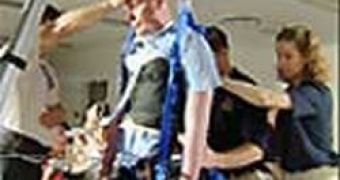Christopher Reeve Foundation's Neuro-Recovery Network has helped a 3-year-old paralyzed boy to walk again.
We always remember "Superman" actor Christopher Reeve, suspended over a treadmill, after the sorrowful riding accident. The paralyzed actor believed that the nervous system could be regenerated through intense physical therapy. He was one of the first patients to try this radical new therapy known as locomotor training, developed by Dr. Susan Harkema, professor of neurosurgery at the Kentucky Spinal Injury Research Center. "The spinal cord itself has a great capacity to learn, to remember, to forget and to make decisions," Harkema said. "And the spinal cord can do that even when it's disconnected from the brain."
Through this therapy the spinal cord is retought how to control motor functions (walking) through repetitive motion. After 15 years of experimentation, the therapy developed in 15 years of experimentation has now strengthened hundreds of spinal cord injury victims and some were even able to walk again.
This miracle is a hope to thousands, including Renee Ford, whose 2-year-old son, Chase, hit his head while jumping on a couch, injuring his spinal cord. "He was pale white... He was shaking, crying uncontrollably. I couldn't even stop him," Ford said. "Chase hit his head so hard that it bruised the central spinal cord area. ... He was actually paralyzed from the neck down."
"To hear that Chase did this much damage to his body, a little tiny body, and he's going to be in a wheelchair forever..." Ford said, crying. A month after the accident, Harkema accepted Chase into the locomotor training. "When I first saw him, he could not move his arms and legs at all," Harkema said. Chase was the youngest patient Hakema ever had, but he responded to the therapy. "The first day we stepped him on the treadmill he came off and he was crying," Harkema said. "And his leg moved out and moved back in and that's when I knew that there was a lot of hope for him."
After a year and a half of hard therapy, Chase walked on his own. "My first thought was, he did it. He did it," Ford said. "If he can do it, a 3-year-old can do it. Anybody can do it."
Chase would like to play baseball when he will be able to run on his own. Hakema said she felt "hope ... and a little sadness that Chris and Dana [Reeve] weren't here to see it."
This is Christopher Reeves' legacy: spinal cord injuries are no longer a life sentence of paralysis. "A little boy from Owensville, Ky., that no one has ever heard of received the cutting-edge therapy, and Dana and Christopher Reeve's vision lives on in Chase," Ford said.

 14 DAY TRIAL //
14 DAY TRIAL //